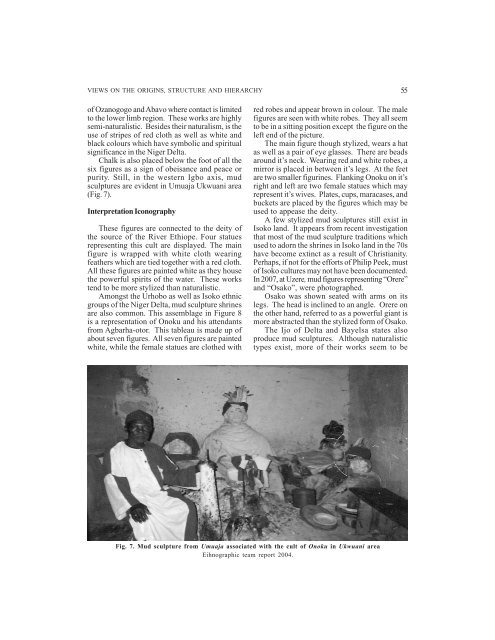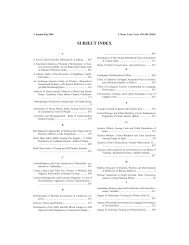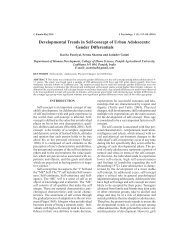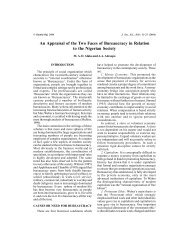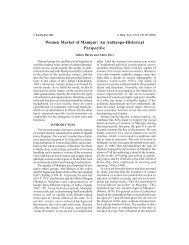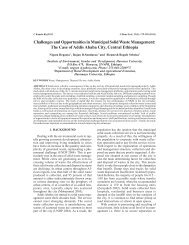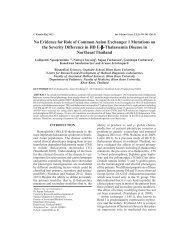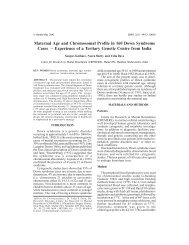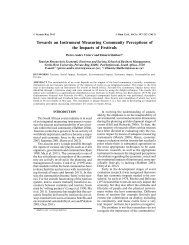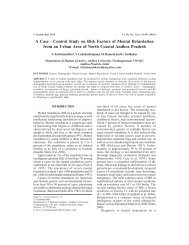Views on the Origins, Structure and Hierarchy of Some Niger Delta ...
Views on the Origins, Structure and Hierarchy of Some Niger Delta ...
Views on the Origins, Structure and Hierarchy of Some Niger Delta ...
You also want an ePaper? Increase the reach of your titles
YUMPU automatically turns print PDFs into web optimized ePapers that Google loves.
VIEWS ON THE ORIGINS, STRUCTURE AND HIERARCHY<br />
<strong>of</strong> Ozanogogo <strong>and</strong> Abavo where c<strong>on</strong>tact is limited<br />
to <strong>the</strong> lower limb regi<strong>on</strong>. These works are highly<br />
semi-naturalistic. Besides <strong>the</strong>ir naturalism, is <strong>the</strong><br />
use <strong>of</strong> stripes <strong>of</strong> red cloth as well as white <strong>and</strong><br />
black colours which have symbolic <strong>and</strong> spiritual<br />
significance in <strong>the</strong> <strong>Niger</strong> <strong>Delta</strong>.<br />
Chalk is also placed below <strong>the</strong> foot <strong>of</strong> all <strong>the</strong><br />
six figures as a sign <strong>of</strong> obeisance <strong>and</strong> peace or<br />
purity. Still, in <strong>the</strong> western Igbo axis, mud<br />
sculptures are evident in Umuaja Ukwuani area<br />
(Fig. 7).<br />
Interpretati<strong>on</strong> Ic<strong>on</strong>ography<br />
These figures are c<strong>on</strong>nected to <strong>the</strong> deity <strong>of</strong><br />
<strong>the</strong> source <strong>of</strong> <strong>the</strong> River Ethiope. Four statues<br />
representing this cult are displayed. The main<br />
figure is wrapped with white cloth wearing<br />
fea<strong>the</strong>rs which are tied toge<strong>the</strong>r with a red cloth.<br />
All <strong>the</strong>se figures are painted white as <strong>the</strong>y house<br />
<strong>the</strong> powerful spirits <strong>of</strong> <strong>the</strong> water. These works<br />
tend to be more stylized than naturalistic.<br />
Am<strong>on</strong>gst <strong>the</strong> Urhobo as well as Isoko ethnic<br />
groups <strong>of</strong> <strong>the</strong> <strong>Niger</strong> <strong>Delta</strong>, mud sculpture shrines<br />
are also comm<strong>on</strong>. This assemblage in Figure 8<br />
is a representati<strong>on</strong> <strong>of</strong> Onoku <strong>and</strong> his attendants<br />
from Agbarha-otor. This tableau is made up <strong>of</strong><br />
about seven figures. All seven figures are painted<br />
white, while <strong>the</strong> female statues are clo<strong>the</strong>d with<br />
red robes <strong>and</strong> appear brown in colour. The male<br />
figures are seen with white robes. They all seem<br />
to be in a sitting positi<strong>on</strong> except <strong>the</strong> figure <strong>on</strong> <strong>the</strong><br />
left end <strong>of</strong> <strong>the</strong> picture.<br />
The main figure though stylized, wears a hat<br />
as well as a pair <strong>of</strong> eye glasses. There are beads<br />
around it’s neck. Wearing red <strong>and</strong> white robes, a<br />
mirror is placed in between it’s legs. At <strong>the</strong> feet<br />
are two smaller figurines. Flanking Onoku <strong>on</strong> it’s<br />
right <strong>and</strong> left are two female statues which may<br />
represent it’s wives. Plates, cups, maracases, <strong>and</strong><br />
buckets are placed by <strong>the</strong> figures which may be<br />
used to appease <strong>the</strong> deity.<br />
A few stylized mud sculptures still exist in<br />
Isoko l<strong>and</strong>. It appears from recent investigati<strong>on</strong><br />
that most <strong>of</strong> <strong>the</strong> mud sculpture traditi<strong>on</strong>s which<br />
used to adorn <strong>the</strong> shrines in Isoko l<strong>and</strong> in <strong>the</strong> 70s<br />
have become extinct as a result <strong>of</strong> Christianity.<br />
Perhaps, if not for <strong>the</strong> efforts <strong>of</strong> Philip Peek, must<br />
<strong>of</strong> Isoko cultures may not have been documented.<br />
In 2007, at Uzere, mud figures representing “Orere”<br />
<strong>and</strong> “Osako”, were photographed.<br />
Osako was shown seated with arms <strong>on</strong> its<br />
legs. The head is inclined to an angle. Orere <strong>on</strong><br />
<strong>the</strong> o<strong>the</strong>r h<strong>and</strong>, referred to as a powerful giant is<br />
more abstracted than <strong>the</strong> stylized form <strong>of</strong> Osako.<br />
The Ijo <strong>of</strong> <strong>Delta</strong> <strong>and</strong> Bayelsa states also<br />
produce mud sculptures. Although naturalistic<br />
types exist, more <strong>of</strong> <strong>the</strong>ir works seem to be<br />
Fig. 7. Mud sculpture from Umuaja associated with <strong>the</strong> cult <strong>of</strong> Onoku in Ukwuani area<br />
Eihnographic team report 2004.<br />
55


